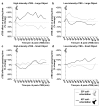Behavioral effects of continuous theta-burst stimulation in macaque parietal cortex
- PMID: 33627702
- PMCID: PMC7904760
- DOI: 10.1038/s41598-021-83904-8
Behavioral effects of continuous theta-burst stimulation in macaque parietal cortex
Abstract
The neural mechanisms underlying the effects of continuous Theta-Burst Stimulation (cTBS) in humans are poorly understood. Animal studies can clarify the effects of cTBS on individual neurons, but behavioral evidence is necessary to demonstrate the validity of the animal model. We investigated the behavioral effect of cTBS applied over parietal cortex in rhesus monkeys performing a visually-guided grasping task with two differently sized objects, which required either a power grip or a pad-to-side grip. We used Fitts' law, predicting shorter grasping times (GT) for large compared to small objects, to investigate cTBS effects on two different grip types. cTBS induced long-lasting object-specific and dose-dependent changes in GT that remained present for up to two hours. High-intensity cTBS increased GTs for a power grip, but shortened GTs for a pad-to-side grip. Thus, high-intensity stimulation strongly reduced the natural GT difference between objects (i.e. the Fitts' law effect). In contrast, low-intensity cTBS induced the opposite effects on GT. Modifying the coil orientation from the standard 45-degree to a 30-degree angle induced opposite cTBS effects on GT. These findings represent behavioral evidence for the validity of the nonhuman primate model to study the neural underpinnings of non-invasive brain stimulation.
Conflict of interest statement
The authors declare no competing interests.
Figures







References
Publication types
MeSH terms
LinkOut - more resources
Full Text Sources
Other Literature Sources
Miscellaneous

